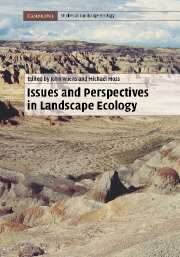Book contents
- Frontmatter
- Contents
- List of contributors
- Preface
- PART I Introductory perspectives
- 1 When is a landscape perspective important?
- 2 Incorporating geographical (biophysical) principles in studies of landscape systems
- PART II Theory, experiments, and models in landscape ecology
- PART III Landscape patterns
- PART IV Landscape dynamics on multiple scales
- PART V Applications of landscape ecology
- PART VI Cultural perspectives and landscape planning
- PART VII Retrospect and prospect
- Index
- Plate section
- References
2 - Incorporating geographical (biophysical) principles in studies of landscape systems
from PART I - Introductory perspectives
Published online by Cambridge University Press: 20 November 2009
- Frontmatter
- Contents
- List of contributors
- Preface
- PART I Introductory perspectives
- 1 When is a landscape perspective important?
- 2 Incorporating geographical (biophysical) principles in studies of landscape systems
- PART II Theory, experiments, and models in landscape ecology
- PART III Landscape patterns
- PART IV Landscape dynamics on multiple scales
- PART V Applications of landscape ecology
- PART VI Cultural perspectives and landscape planning
- PART VII Retrospect and prospect
- Index
- Plate section
- References
Summary
The geographical and biological roots of landscape ecology are in Central and Eastern Europe. Here landscape has always been treated in a holistic manner, starting from von Humboldt (1769–1859), who defined landscape as a holistic characterization of a region of the earth. In 1850 Rosenkranz defined landscapes as hierarchically organized local systems of all the kingdoms of nature. The term “landscape ecology” was introduced by Troll in the late 1930s. He proposed that the fundamental task of this discipline be the functional analysis of landscape content as well as the explanation of its multiple and varying interrelations. Later he modified the definition by referring to Tansley's concept of the ecosystem. In this approach, landscape ecology is the science dealing with the system of interconnections between biocenoses and their environmental conditions in definite segments of space (Richling and Solon, 1996).
A further impulse to the development of landscape ecology was provided by the concepts drawn up in the 1950s within vegetation science. Particularly worthy of emphasis here is the work of Tüxen (1956), which introduced the concept of potential natural vegetation, as well giving rise to that of dynamic circles of plant communities; of Dansereau (1951), who was the first to apply the landscape concept in biogeography; and of Whittaker (1956), whose gradient analysis approach remains as important as ever.
- Type
- Chapter
- Information
- Issues and Perspectives in Landscape Ecology , pp. 11 - 20Publisher: Cambridge University PressPrint publication year: 2005
References
- 5
- Cited by



